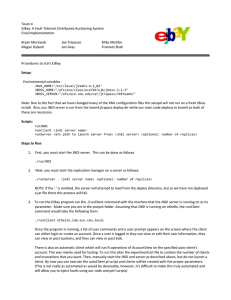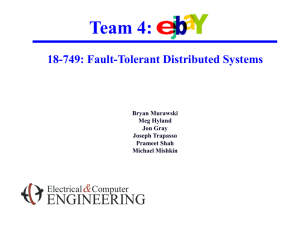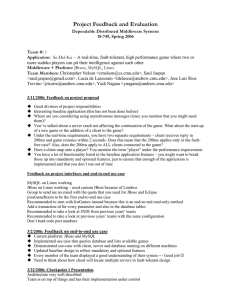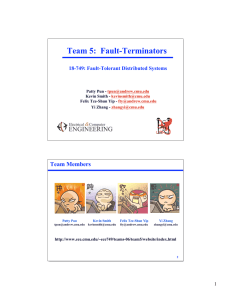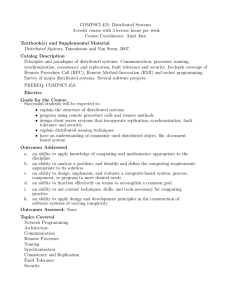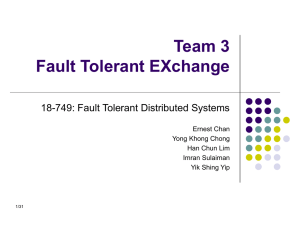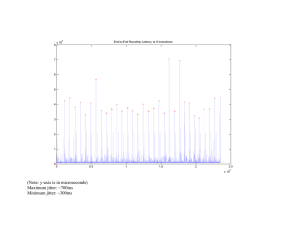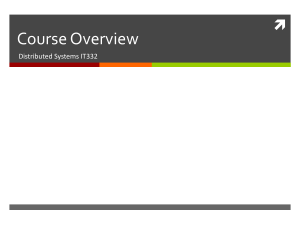Team 4: 18-749: Fault-Tolerant Distributed Systems Bryan Murawski Meg Hyland
advertisement
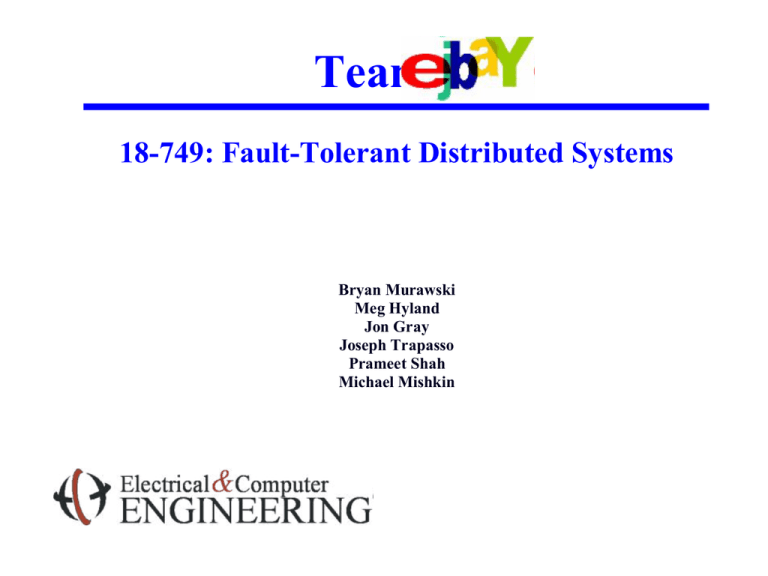
Team 4: 18-749: Fault-Tolerant Distributed Systems Bryan Murawski Meg Hyland Jon Gray Joseph Trapasso Prameet Shah Michael Mishkin Team Members BrYan Murawski bmurawsk@andrew.cmu.edu Meg Hyland mhyland@andrew.cmu.edu Jonathan Gray jongray@cmu.edu Michael Mishkin mmishkin@andrew.cmu.edu Joe Trapasso jtrapass@andrew.cmu.edu Prameet Shah phs@andrew.cmu.edu http://www.ece.cmu.edu/~ece749/teams-06/team4/ ‹ #› Baseline Application System Description – Baseline Applications – – – Au s e rc a nc r e a t e ,l o gi n ,up d a t e ,l og ou t ,v i e wot he ru s e r s ’a c c ounti nf o r ma t i o n . A user can post, view, search, post a bid, view bid history of auctions. Application Exceptions: DuplicateAccount, InvalidAuction, InvalidBid, InvalidUserInfo, InvalidUserPass, UserNotLoggedIn Why is it Interesting? – EJBay is a distributed auctioning system that allows users to buy and sell items in an auction plaza A service used by many commercial vendors. Configuration – Operating System • Server & Client: Linux – Language • Java SDK 1.4.2 – Middleware • Enterprise Java Beans – Third-party Software • Database: MySQL • Application Server: JBoss • IDE: XEmacs, Netbeans ‹ #› Baseline Application –Configuration Selection Criteria Operating System: Linux – – Enterprise Java Beans (EJB) – – – – – Easily available on the servers. Environment that was used in previous projects. XEmacs – – Wor l d’ smos tp opul a rope ns our c eda t a b a s e . Easy to install and use. Couple of group members knew it well. JBoss – Popular technology in the industry. Ev e r yme mbe r s ’pr e f e r e n c e . MySQL – Easier to use, since ECE clusters are configured. System is managed and backed up nightly by Computing Services. Most commonly learned text editor. Members were familiar with syntax. Netbeans – – Easy to install and incorporates tab completion. Allows you to see available functions within a class. ‹ #› Baseline Architecture ‹ #› Experimental Evaluation –Architecture Unmodified Server Application New Automated Client – – Experimental variables taken as command-line inputs Performs specified number of invocations and dies Central Library of MATLAB scripts – – One script to read in data from all probes Others scripts each responsible for a specific graph ‹ #› Experimental Evaluation –Results Expected results – – – – Increasing clients yield increasing latency Most time spent in Middleware “ Ma g i c a l1 %” Slightly longer latencies in non-standard reply size cases Actual results – – Memory / Heap problems Java optimizations changing behavior of code •Shorter latency in non-standard reply size cases – – – Database INSERTs take much longer than SELECTs Onl ye x hi b i t e d“ Ma g i c a l1 %”t os o mee x t e n t Very high variability and some unusual/unexpected results •During test runs close to deadline; very high server/database loads ‹ #› Experimental Evaluation –Original Latency – First set of experiments revealed unusual characteristics at high load – Default Java heap-size was not large enough – Garbage collector ran constantly after ~4500 requests w/ 10 clients ‹ #› Experimental Evaluation –Improved Latency – Increased heap from default to 300MB ‹ #› Experimental Evaluation –Improved Latency – Mean and 99% Latency area graph only loosely exhibited the “Ma g i c1%”behavior ‹ #› Fault-Tolerance Framework Replicate servers – – – Passive replication Stateless servers Allow for up to 14 replicas • One for each machine in the Games cluster (minus ASL and Mahjongg) Sacred Machines – – – – – Clients Replication Manager Naming Service Fault Injector Database Elements of Fault-tolerance Framework – Replication Manager • Heartbeat • Fault detector • Automatic recovery (maintenance of number of replicas) – Fault Injector ‹ #› FT-Baseline Architecture ‹ #› Replication Manager Responsible for launching and maintaining servers Heartbeats replicas periodically – Differentiates between crash faults and process faults – – A server is already running on the current machine remove from active list Maintains global JNDI – – – Crash fault: Server is removed from the active list Process fault: Process is killed and restarted Catches port binding exceptions – 500ms period Updating server references for clients Indicates which server is primary/secondary Keeps a count of the number of times any primary has failed Advanced Features – – Allows the user to see the current status of all replicas Allows the user to see the bindings in the JNDI ‹ #› Fault Injector 2 Modes Manual Fault Injection – Ru nsa“ k i l l-9”o nau s e rs p e c i f i e ds e r v e r Periodic Fault Injection – Prompts user to set up a kill timer •Base period •Max jitter about the base period •Option to only kill primary replica, or a random replica ‹ #› Mechanisms for Fail-Over Replication Manager detected fail-over – – – – – Detects that a heartbeat thread failed Kills the associated server Checks cause of death Launches new replica If no active servers are free, the replication manager will print a message, kill all servers and exit Client detected fail-over – – Receives a RemoteException Queries naming service for a new primary •Previously accessed JNDI directly – Required a pause for JNDI to be corrected •Sometimes this resulted in multiple failover attempts – When JNDI was not ready after predetermined wait time ‹ #› Round Trip Client Latency w/Faults Average Latency for all Invocations –12.922 ms ‹ #› Fail-Over Measurements – Half fault time is client delay waiting for JNDI to be updated – Rest of time spent between detection and correction in Rep Manager – This discrepancy between delay-time and correction time is the major target for improvement ‹ #› RT-FT-Baseline Architecture Improvements Target fault-detection and correction time in Replication Manager – – Tweaking heartbeat frequency and heartbeat monitor frequency Improvements in interactions with JNDI •Additional parameters to specify primary server •Update JNDI by modifying entries rather than rebuilding each time Target fail-over time in client – – – Client pre-establishes connections to all active servers Background thread queries JNDI and maintains updated list On fail-over, client immediately fails-over to next active server •No delay waiting for Replication Manager to update JNDI •Ba c kgr oun dt h r e a dwi l ls y nc h r oni z ec l i e n t ’ ss e r v e rl i s ton c ei th a sbe e nupda t e dby the Replication Manager ‹ #› RT-FT-Baseline Architecture ‹ #› RT-FT- Post-Improvement Performance Old 1 Client Measurements Avg. Latency for all Invocations: 12.922ms Avg. Latency during a Fault: 4544ms New 1 Client Measurements Avg. Latency for all Invocations: 16.421ms Avg. Latency during a Fault: 806.96ms (82.2% Improvement) ‹ #› RT-FT- Post-Improvement Performance –4 Clients New 4 Client Measurements Avg. Latency for all Invocations: 47.769ms Avg. Latency during a Fault: 1030.1ms ‹ #› RT-FT- Post-Improvement Performance More even distribution of time Client reconnect time still dominates, but is a much smaller number ‹ #› Special Features Experimental Evaluation – – – Fault-Tolerant Baseline – – – Utilized JNI for microsecond precision timers Maintained a central library of MATLAB processing scripts Perl and shell scripts to automate entire process Powerful Replication Manager that starts, restarts, and kills servers Integrated command-line interface for additional automation Fault-Injector with dual-modes Fault-Case Performance – – New client functionality to pre-establish all connections Contents of JNDI directly correlated to actual status of servers •Online, offline, booting ‹ #› Open Issues Problems launching multiple servers concurrently from Rep Manager – – Improved Client Interface – Many attempts to address/debug this issue with only some success If multiple faults occur within short period of time, some servers may die unexpectedly GUI or Web-Based Additional Application Features – – – Allow deletion of accounts, auctions, and bids Security! Improved search functionality ‹ #› Conclusions What we have learned – – – What we accomplished – – Stateless middle tier requires less overhead XML has poor documentation. XDoclet would have been a good tool to use. Running experiments takes an extremely long time. Automating test scripts increases throughput. A robust fault-tolerant system with a fully automated Replication Manager Fully automated testing and evaluation platform What we would do differently – – Spending more time with XDoclet to reduce debugging Use one session bean instead of separating functionality into two ‹ #›
